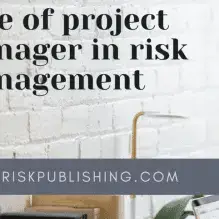Risk management is an essential aspect of project management that entails identifying, analyzing, and responding to potential risks that can affect the success of a project.
Project managers should engage in risk management at all stages of a project, as follows:
Project Initiation: At this early stage, project managers should begin considering potential risks. A preliminary risk assessment should be included in the project charter or initiation document, outlining any known risks or uncertainties associated with the project.
Project Planning: During this phase, project managers should perform a comprehensive risk analysis involving identifying and assessing potential risks. They should also develop a risk management plan outlining how the project team will handle risks.
This includes specifying roles and responsibilities, risk tolerance thresholds, and procedures for tracking and reporting risks.
Project Execution: While executing the project, project managers should monitor and control risks as outlined in the risk management plan. This includes tracking identified risks, monitoring residual risks, identifying new risks, and executing the risk response plans when necessary.
Project Monitoring and Control: Continuous monitoring of risks is crucial during this phase. The project manager should ensure that risk response plans work and adjust them as necessary. They should also continuously reassess existing risks and identify new ones, as risks can change as the project progresses.
Project Closure: At the end of the project, a review should be performed to analyze how risks were managed and to draw lessons for future projects. This can help improve the organization’s risk management processes for future projects.
Project managers must manage risk throughout the project’s life cycle to ensure timely delivery within budget constraints while maintaining stakeholder satisfaction.
The identification of risks should be made early in the planning phase to allow for sufficient time and resources for mitigation strategies.
The process involves identifying potential risks impacting a project’s timeline, performance, or budget. These risks can be categorized into different types, such as technical, financial, legal, environmental, or organizational risks.
Analyzing these risks allows project managers to assess their likelihood of occurrence and potential impact on the project’s objectives. Through risk prioritization and according to their severity and impact on the project’s success criteria, they can create a risk management plan that outlines specific actions required if certain events occur.
Effective communication with stakeholders about potential risks ensures that everyone is aware of possible issues and can work together towards mitigating them before they become critical problems.

Timing for Risk Identification
The timing for risk identification is a crucial aspect of effective risk management in project planning. It involves identifying potential risks at the earliest stages of the project lifecycle to minimize negative impacts on timeline, performance, and budget.
Early identification enables project managers to perform a risk assessment and proactive planning, allowing them to take preemptive measures before risks escalate into significant issues. Effective risk management requires a timely response to identified risks.
Engaging in risk identification early in the project lifecycle allows project managers to respond promptly and efficiently. This helps prevent minor issues from developing into significant problems derailing the project plan. Project managers can develop contingency plans and allocate resources by proactively identifying potential risks.
Early identification of potential risks also ensures stakeholders are informed about any challenges that may arise during the project. This promotes transparency and helps build trust between stakeholders and the project team.
Through clear communication channels established early on, stakeholders are better equipped to make informed decisions about mitigating identified risks while staying aligned with their overall goals for the project.
When to Analyze Risks
Timing of risk analysis is a critical factor in effective project planning, as it allows for early identification and mitigation of potential risks. Early identification involves recognizing and proactively addressing potential risks before they become problems.
Risk assessment analyses the likelihood and impact of identified risks, which helps prioritize risk response strategies.
Proactive planning involves anticipating potential risks and developing plans to mitigate or manage them. This approach enables project managers to take action before issues arise, reducing the chances of delays or budget overruns.
Risk response includes implementing strategies that address identified risks, such as avoiding, transferring, mitigating or accepting them.
Continuous evaluation involves monitoring the effectiveness of risk management strategies throughout the project lifecycle and making adjustments as needed.
Effective risk management requires a proactive approach that includes early identification, risk assessment, proactive planning, risk response and continuous evaluation.
Proactive planning can help prevent negative consequences from arising while enabling teams to deliver projects on time and within budget constraints.
Regularly evaluating risk management strategies ensures they remain effective over time and allows stakeholders to make appropriate changes.
Prioritizing Risks
Prioritization of risks is a crucial aspect of proactive planning in project risk management. Risk ranking and categorization are necessary to determine which risks require immediate attention and which can be addressed later.
The process involves assessing the probability and impact of each risk, assigning it to a category, and developing appropriate mitigation strategies.
Risk assessment begins with identifying potential risks affecting the project timeline, budget, or performance. Once identified, these risks must be ranked according to their severity level. This allows project managers to allocate resources effectively and prioritize the most significant risks.
Additionally, categorizing risks into high, medium, or low helps determine the urgency required for each risk. Risk probability refers to the likelihood that an event will occur, while risk impact relates to the severity of its consequences. These two factors help determine how much effort should be invested in mitigating each risk.
Prioritization based on probability and impact ensures that limited resources are utilized optimally by focusing only on those risks that present the greatest threat.
Prioritizing risks is critical for effective project management as it enables teams to develop appropriate mitigation strategies that address the most pressing issues first.
Risk ranking allows teams to make informed decisions about allocating resources while categorizing them based on severity ensures that efforts are directed towards those with higher impacts on project outcomes.
Taking a proactive approach towards managing potential threats through effective prioritization techniques, such as analyzing probability and impact levels within a given context, can lead towards successfully delivering projects within budgetary constraints and timelines set forth by stakeholders involved in such initiatives.
Creating a Risk Management Plan
Creating a comprehensive risk management plan involves identifying potential risks that may impact the project, analyzing their probability and impact, developing appropriate mitigation strategies, assigning an owner to each risk, and monitoring progress towards resolving them.
To achieve this, project managers need to use risk assessment tools such as SWOT analysis or PESTLE analysis to identify external factors that could affect the project. They also need to prioritize risks based on their likelihood of occurrence and impact on the project.
Contingency planning is another critical aspect of creating a risk management plan. This involves developing backup plans in case certain risks occur.
For instance, if there is a delay in receiving supplies from a supplier due to unforeseen circumstances like natural disasters or strikes, contingency plans should be implemented to ensure the project continues without interruptions.
Additionally, having a well-defined risk response plan ensures that team members know what actions to take when specific risks are identified.
An organisation’s robust risk management culture can significantly reduce risk exposure and improve decision-making processes by providing reliable data for making informed decisions.
This culture should be supported by effective communication channels that enable stakeholders at all levels of the organization to report any potential risks promptly. Regular reports should also be prepared on risk status and communicated through established reporting mechanisms.
Takeaways
- Risk assessment tools such as SWOT analysis or PESTLE analysis should be used.
- Prioritizing risks based on their likelihood of occurrence and impact on the project is necessary.
- Contingency planning involves developing backup plans in case certain risks occur.
- A well-defined risk response plan ensures team members know what to take when identifying specific risks.
Creating a comprehensive risk management plan is crucial for completing any project. Project managers must identify potential risks early enough to develop appropriate mitigation strategies before they become significant issues.
Implementing contingency plans, having a well-defined risk response plan, and fostering a robust risk management culture within an organization are essential elements of an effective risk management plan.
Regularly monitoring and reporting on risks throughout the project lifecycle, project managers can ensure they remain in control and deliver projects successfully within budget and timeline constraints.

Ongoing Risk Monitoring
One key aspect of effective risk management in project planning is monitoring and evaluating potential risks throughout the project lifecycle. This requires a continuous monitoring process that allows for the proactive identification and response to potential risks as they arise.
To ensure that ongoing risk monitoring is effective, it is essential to understand the risks that may impact the project. The table below outlines some common types of risks and examples of how they might manifest in a project:
| Type of Risk | Causes |
|---|---|
| Technical | Software bugs or hardware failures |
| Resource | Lack of necessary staff or equipment |
| Schedule | Delays in delivery or unexpected changes to timeline |
Regularly reviewing these and other potential risks, project managers can take a proactive approach to risk management. This involves identifying new risks as they emerge and updating the risk response plan with appropriate mitigation strategies.
Ongoing risk monitoring is essential for successful project planning. Organizations can reduce negative consequences by taking a real-time approach to identifying and responding to potential risks while ensuring timely completion within budget constraints.
Effective implementation of this strategy requires clear communication channels between all stakeholders involved in the project.
Frequently Asked Questions
What are some common tools used for risk identification?
Standard tools for risk identification include brainstorming techniques, SWOT analysis, expert judgment, historical data analysis, and checklists. These analytical and proactive methods can help project managers identify potential risks before they become issues.
How can project managers effectively communicate risks to stakeholders?
Effective risk communication involves assessing risks, engaging stakeholders, planning for mitigation, and developing response plans. Clear and concise language should convey the impact and likelihood of risks and potential solutions.
What are some potential consequences of not engaging in risk management?
Not engaging in risk management can incur costs, project delays, reputation damage, resource wastage, and legal issues. Proactive risk management can prevent these consequences by identifying, analyzing, and responding to potential risks throughout the project lifecycle.
How can project managers determine the appropriate level of risk appetite for their organization?
Project managers must conduct a risk assessment to identify potential risks and their impact to determine the appropriate level of risk appetite for an organisation. They should also consider the organization’s risk tolerance and develop a risk mitigation plan with clear risk response strategies. Continuous risk monitoring is crucial to adjust the level of risk as needed.
What are some strategies for managing positive risks/opportunities?
To maximize the benefits of positive risks/opportunities, project managers should conduct cost analysis and engage in risk mitigation strategies such as contingency planning. Stakeholder involvement is crucial in identifying and prioritizing these opportunities.

Conclusion
Project managers must engage in risk identification and analysis early in the project planning process to mitigate potential risks that may impact the project’s timeline, performance or budget.
Prioritizing risks and creating a comprehensive risk management plan, project managers can proactively address potential issues before they become critical problems.
Ongoing risk monitoring throughout the project lifecycle is also essential to ensure that any new risks are identified promptly and managed effectively. Clear communication about potential risks and mitigation strategies is vital for maintaining stakeholder satisfaction.
Using various tools and techniques such as brainstorming sessions, SWOT analysis, and scenario planning, project managers can identify potential causes of risks and develop appropriate mitigation strategies.
Adopting a proactive approach to risk management in their projects, project managers can deliver projects on time and under budget while meeting stakeholder expectations.

Chris Ekai is a Risk Management expert with over 10 years of experience in the field. He has a Master’s(MSc) degree in Risk Management from University of Portsmouth and is a CPA and Finance professional. He currently works as a Content Manager at Risk Publishing, writing about Enterprise Risk Management, Business Continuity Management and Project Management.

